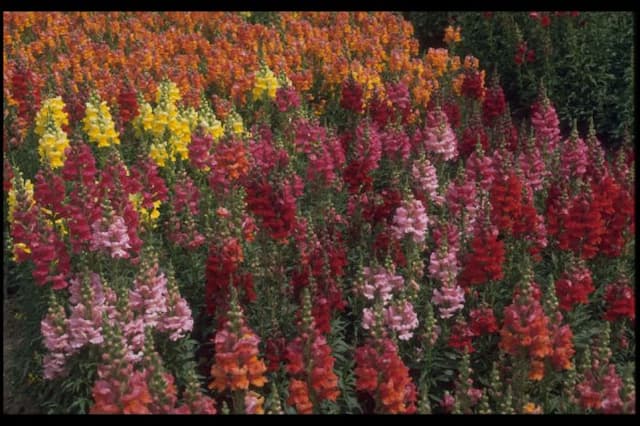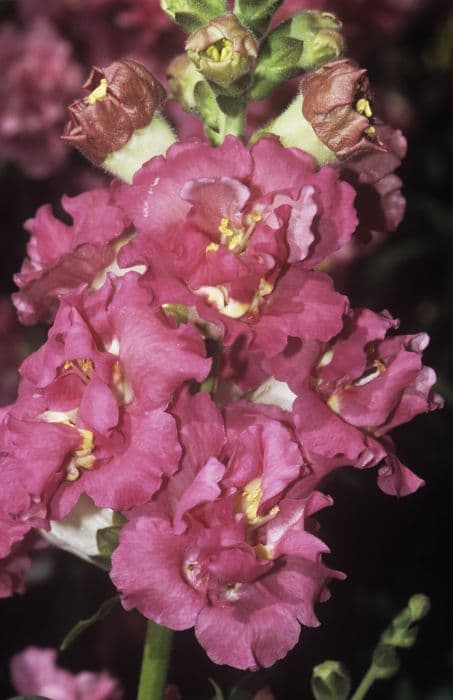Penstemon 'Blue Riding Hood' Penstemon 'Blue Riding Hood' (PBR) (Riding Hood Series)

ABOUT
'Blue Riding Hood' has metallic blue blowers with a white throat. Compact well-branched cultivar growing about 60cm high.
About this plant
 Names
NamesFamily
Plantaginaceae
Synonyms
Beardtongue, Blue Riding Hood Penstemon
Common names
Penstemon 'Blue Riding Hood' (PBR)
 Characteristics
CharacteristicsLife cycle
Perennials
Foliage type
Deciduous
Color of leaves
Green
Flower color
Blue
Height
2 feet (60 cm)
Spread
2 feet (60 cm)
Plant type
Herb
Hardiness zones
4
Native area
North America
Benefits
 General Benefits
General Benefits- Attracts Pollinators: Penstemon 'Blue Riding Hood' is known to attract bees, butterflies, and other pollinating insects, enhancing biodiversity.
- Drought Tolerant: Once established, it has a strong tolerance for dry conditions, making it suitable for water-conservation gardens.
- Long Blooming: Produces flowers over a long period, typically from late spring to early fall, providing extended visual interest.
- Low Maintenance: Requires minimal care once established, with occasional deadheading to promote blooming.
- Cold Hardy: This cultivar can withstand colder temperatures making it a good choice for gardens in temperate regions.
- Versatile Landscaping: Suitable for perennial borders, rock gardens, and container gardening due to its compact growth habit.
- Aesthetic Appeal: Features showy deep blue flowers, which add vibrant color to any garden space.
- Deer Resistant: Generally resistant to browsing by deer, which is an advantage in areas where deer predation is a problem.
 Medical Properties
Medical PropertiesThis plant is not used for medical purposes.
 Air-purifying Qualities
Air-purifying QualitiesThis plant is not specifically known for air purifying qualities.
 Other Uses
Other Uses- Photography Prop: Penstemon 'Blue Riding Hood' is vibrant and photogenic, making it an excellent subject for botanical photography and garden portfolios.
- Educational Tool: Due to its unique color and form, this penstemon can be used to teach botany students about plant identification and hybridization processes.
- Color Dye: The flowers of the Penstemon 'Blue Riding Hood' can be used to create a natural dye for fabrics, though not a common use.
- Ink Making: Similarly, the intense blue hue of the flowers can be used to make a plant-based ink for art projects.
- Theme Gardens: This penstemon variety can be used to design a 'blue-themed' garden or a storybook-themed garden inspired by its "Riding Hood" series.
- Pressing and Scrapbooking: The blooms of this plant are suitable for pressing and can be used for creating personalized stationery or to embellish scrapbooks.
- Pottery Glaze Inspiration: Ceramic artists may use the distinctive blue of the Penstemon 'Blue Riding Hood' as an inspiration for new glazes or pottery designs.
- Set Design: Due to its striking appearance, this plant can be used in set designs for theater and film, particularly in outdoor scenes or fantasy settings.
- Floral Language Education: Use the Penstemon 'Blue Riding Hood' to teach enthusiasts about the language of flowers, in which different blooms represent various symbols and messages.
- Eco-Friendly Confetti: Petals of the Penstemon 'Blue Riding Hood' can be dried and used as biodegradable confetti for outdoor celebrations.
Interesting Facts
 Feng Shui
Feng ShuiThe Beard Tongue is not used in Feng Shui practice.
 Zodiac Sign Compitability
Zodiac Sign CompitabilityThe Beard Tongue is not used in astrology practice.
 Plant Symbolism
Plant Symbolism- Communication: Penstemons have tubular flowers that are reminiscent of a mouthpiece or trumpet, which can symbolize the idea of communication and expression.
- Strength: The word 'Penstemon' comes from two Greek words that mean "five" and "stamen," with the fifth stamen being a sterile one. The unique fifth stamen represents strength and endurance.
- Beauty: With its striking blue flowers, the 'Blue Riding Hood' Penstemon may symbolize beauty and appreciation for the natural aesthetic.
- Diversity: Penstemons are known for their wide range of colors and forms, which can represent the value of diversity and variety in life.
- Healing: Some species of Penstemon are used in traditional medicine, and their presence in a garden might symbolize a wish for health and well-being.
 Water
WaterBeardtongue, the common name for Penstemon 'Blue Riding Hood', requires consistent moisture but does not like to be waterlogged. It is best to water the plant deeply once a week, providing about one to two gallons depending on the size of the plant and the local climate conditions. During the heat of summer, you might need to water twice a week if the plant is in full sun and temperatures are high. It's important to avoid overhead watering to prevent leaf diseases; thus, water at the base of the plant. Reduce watering in the fall to help harden off the plant before winter.
 Light
LightBeardtongue thrives in full sun to partial shade, with at least six hours of sunlight each day being ideal. It should be placed in a spot where it can receive unfiltered morning sunlight and some afternoon shade, particularly in areas with very hot summers, to protect it from the most intense heat of the day.
 Temperature
TemperatureBeardtongue is hardy and can withstand a range of temperatures but grows best when the temperature is between 60°F and 90°F. It can survive minimum winter temperatures down to about -30°F. The ideal temperature conditions for the plant are moderate to warm during the growing season with cool to cold winters that help it go dormant and rest.
 Pruning
PruningBeardtongue should be pruned to promote bushiness and more blooms. Deadhead spent flowers regularly to encourage more blooms. After the first killing frost, cut back the plant to about an inch above ground level to tidy up the garden and prepare it for winter. Pruning is also an opportunity to shape the plant and remove any weak or damaged stems.
 Cleaning
CleaningAs needed
 Soil
SoilBeardtongue prefers well-draining soil with a mixture of loam, sand, and compost. Aim for a soil pH of 6.0 to 8.0 for optimal growth and flowering.
 Repotting
RepottingBeardtongue should be repotted every 3-4 years or when it outgrows its current container, ensuring fresh soil and space for growth.
 Humidity & Misting
Humidity & MistingBeardtongue thrives in moderate humidity levels and does not require any specific humidity adjustments when grown outdoors in its preferred climate.
 Suitable locations
Suitable locationsIndoor
Place in bright light, ensure pot has drainage, avoid overwatering.
Outdoor
Full sun to partial shade; protect from harsh winds; mulch to retain moisture.
Hardiness zone
4-9 USDA
 Life cycle
Life cycleThe Penstemon 'Blue Riding Hood', commonly known as Beardtongue, begins its life as a seed which, when sown in fertile, well-draining soil and exposed to at least partial sunlight, germinates to develop into a seedling. The young plant then enters a vigorous vegetative growth phase, establishing a strong root system and producing lance-shaped leaves and stems. As it matures, it transitions into the flowering stage, typically from late spring to early summer, where it produces its vivid blue, tubular flowers that attract pollinators such as bees and hummingbirds. After pollination, flowers develop into fruit capsules containing seeds that can be dispersed by wind or wildlife, thereby completing its reproductive cycle. During the autumn, the plant begins to die back as temperatures drop, entering a dormant phase particularly if it is in a region with cold winters, although it's a perennial and will regrow from its root system with the arrival of warm spring weather. Throughout its life, the Beardtongue requires regular watering, especially during dry periods, and may benefit from the removal of spent flower stalks to encourage further blooming and to maintain plant vigor.
 Propogation
PropogationPropogation time
Spring to Summer
Propogation: The Penstemon 'Blue Riding Hood', commonly known as Beardtongue, is often propagated through stem cuttings, a popular method because it helps maintain the characteristics of the parent plant. The optimal time for taking stem cuttings is late spring to early summer, when the plant is actively growing. To propagate by stem cuttings, select a healthy, non-flowering stem and cut a 4 to 6-inch piece, making sure there are several leaf nodes present. Remove the leaves from the lower half of the cutting, dip the cut end into rooting hormone powder, and then insert it into a well-draining soil mix. The cutting should be kept moist but not wet, and placed in indirect light. After a few weeks, roots should develop, at which point the new plant can slowly be acclimated to more direct light before eventually being planted outdoors.





![Snapdragon [Pretty in Pink]](/_next/image?url=https%3A%2F%2Fplants-admin.emdemapps.com%2Fimages%2Fplants%2F%2Fimages%2F604b5cb3b5385.png&w=640&q=75)



